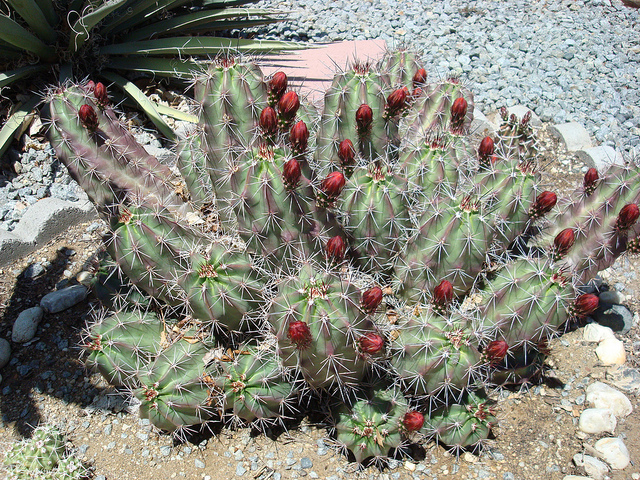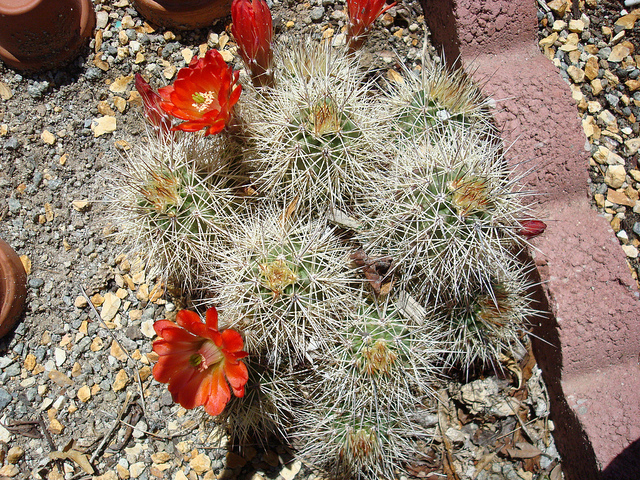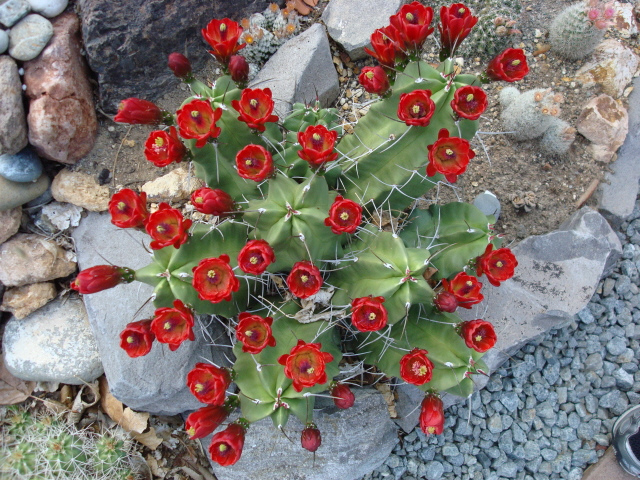Echinocereus triglochidiatus is found growing various habitats of the Mojave Desert, in the states of NV, UT, CO, CA, AZ, and TX also into northern Mexico. Look for it on rocky slopes, hill country scrub lands, open forest lands, rocky outcroppings and cliff faces.
This species is comprised of a complex group of local populations. In this variable species the appearances of these populations differ markedly. There are many designated forms and varieties, however at this point they are not all are universally recognized. It is in my opinion best to use the collection location (if known)to differentiate between the differant forms.
Echinocereus triglochidiatus grow as upright mounding groups of cylindrical stems. From a few to hundreds of clumping stems. Stems are usually dark green and can be up six inches across. In White Sands, New Mexico they can stand up to thirty inches tall but across most of their range 12-24 inches is more of an average. The ribs can vary from as few as 5 to as many as 12.
Spine shapes, thickness, count, length and color vary widely. 3-11 spines per areole straight to curved or twisted. White to yellow, or gray to almost black. Angular in cross section to oval.
The flowers are tubular long lasting, dark scarlet to bright orange red with a thick waxy look. The flowers are pollinated by hummingbirds but I have also seen many a bee dive in to retrieve some pollen. I have never seen the hummers at the flowers. By the time they bloom for me (mid to late June) the hummingbirds are in the mountains feeding. They don't like the summer heat.
Good drainage, full sun exposure and regular deep soakings once every week or two produce healthy actively growing clumps. Chilly sunny winters to promote blossoms. They grow in areas that receave monsoon rains in the summer so like an intermittent soaking through the summer. Hardiness varies from highs of about 20 F (-6 C) to 0 F> (-17> C) depending on the population. I have heard they can take colder temps but have not grown them any colder.
They are touchy about being moved once established and if you have to move them, (bite the bullet) leave them out of the ground in the shade for a minimum of two weeks before you replant them. They rot easily if the wounds inflicted by the move have not callused over properly. When you can't stand to see them out of the ground anylonger and must replant them or go insane, (bite the bullet again) do not water them for at least two weeks.
http://www.efloras.org/florataxon.aspx?flora_id=1&taxon_id=242415252
http://www.swcoloradowildflowers.com/Pink%20Enlarged%20Photo%20Pages/ech...
The following shots are of mature plants growing in the garden of Charles Barnum , a friend who also lives and gardens in Sparks, NV. you should be able to see some of the variation in growth and appearance I mentioned.



